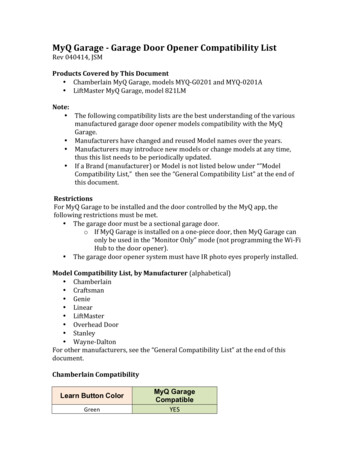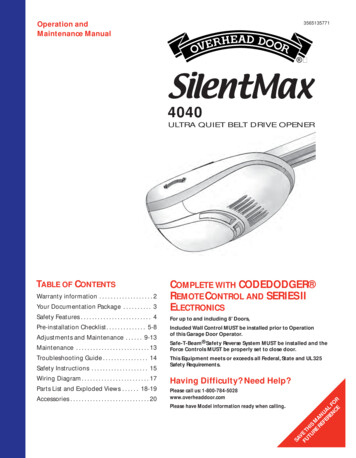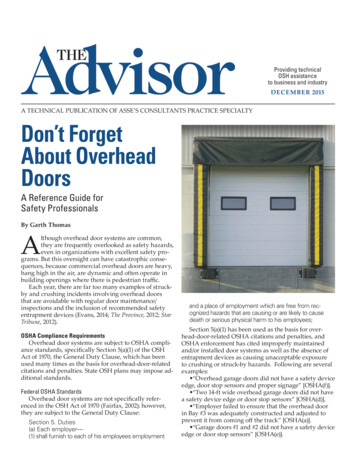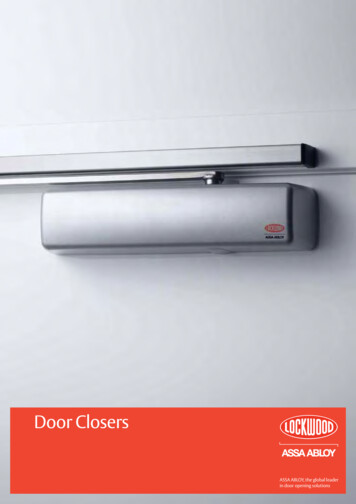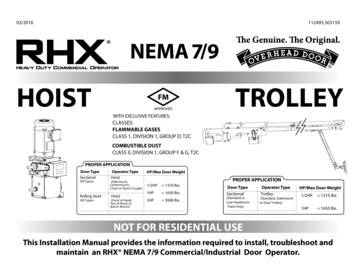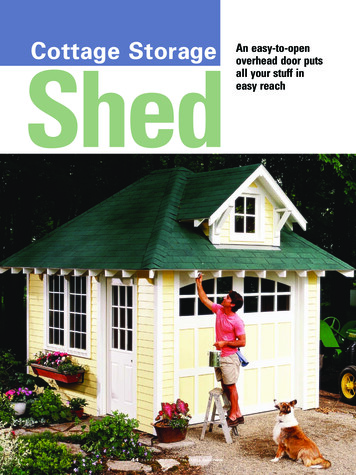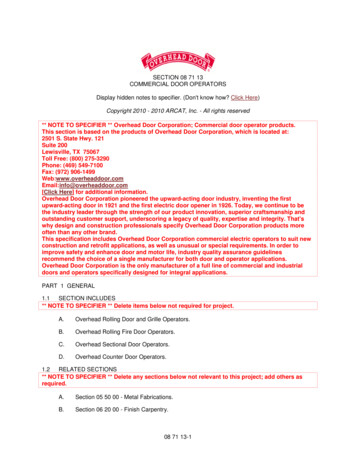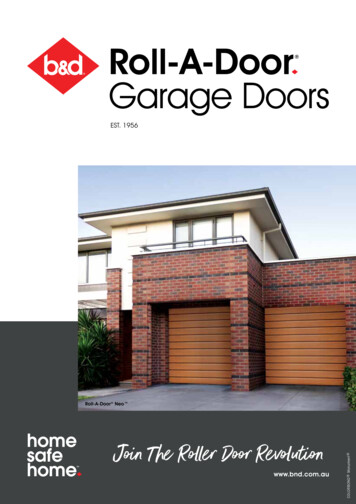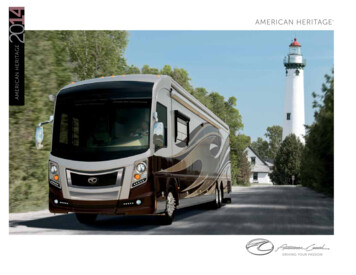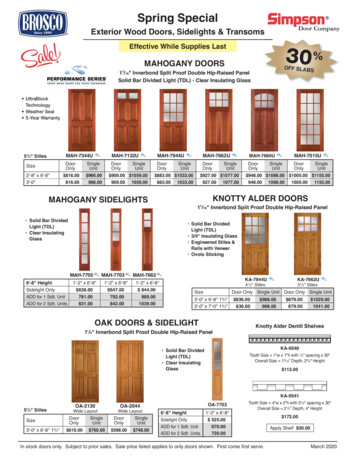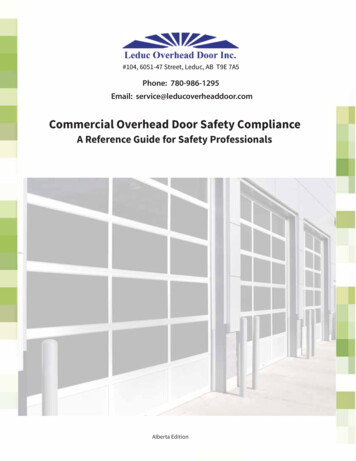
Transcription
#104, 6051-47 Street, Leduc, AB T9E 7A5Phone: 780-986-1295Email: service@leducoverheaddoor.comCommercial Overhead Door Safety ComplianceA Reference Guide for Safety ProfessionalsAlberta Edition
This guide is written for safety professionals with safety and OHS compliance responsibility in organizationswith commercial overhead door systems.SummaryEven though overhead door systems are very common,they are almost always overlooked as safety hazards,even in organizations with excellent safety programs.But this oversight can have catastrophic consequencesas commercial overhead doors are heavy, hang high inthe air, are dynamic, and often operate in buildingopenings where there is pedestrian traffic.Main types of commercial overhead doors:Sectional doorsRolling steel service doorsRolling steel fire doorsHigh speed doorsRubber doorsFabric doorsRolling grillesEach year, there are far too many examples of “struckby” and “crushing” incidents1, 2, 3 involving overheaddoors that are avoidable given regular doormaintenance / inspections, and the inclusion ofrecommended safety entrapment devices.OHS ComplianceOverhead doors systems are subject to OHScompliance requirements. In Alberta, the applicablestandards are Part 3(12)(d) of the Code4, whichrequires equipment to be installed and maintained inaccordance with manufacturer’s specifications; and,Section 2(1) of the Act5, the “general duty of care”provision.Sectional overhead doorHow to Properly Include Overhead Doors in Your Safety ProgramTo comply with OHS regulations, and minimize safety risk, a planned maintenance and safety complianceprogram must be implemented for your overhead doors that meets the criteria below. Inspection,maintenance and repair work is typically performed by a qualified overhead door service company.1. Maintenance Practices, Standards & IntervalsAll door systems must be installed, inspected & maintained in accordance with themanufacturers’ specifications. This includes maintenance intervals, which can vary dependingon daily cyclage and operating environment. If manufacturer’s specifications are not available, thenthe PM program should adhere to established industry standards/best practices.2. Documentation & ReportingThorough, secure documentation should be maintained that details:The practices and standards used to inspect and maintain doors (eg. manufacturer’soperating/maintenance manuals, or similar documentation)Any problems or deficiences found, preferably with photographs2
Corrective work required, and/or opportunites to improve safetyCorrective work performed3. Entrapment DevicesAll motorized door systems must be equipped with entrapment devices to manufacturer’sstandards, such as photo-eyes or sensing edges. If there are door systems equipped with olderdevices not current with newer, improved safety standards, modernizing should be considered wherereasonably practicable; for example, upgrading to monitored entrapment devices.Occupational Health & Safety Legislation in AlbertaOverhead doors are subject to the standards of Part 3(12)(d) of the Alberta Health and Safety Code4and Section 2(1) of the Act5.12 An employer must ensure that .(d) equipment and supplies are erected, installed, assembled, started, operated,handled, stored, serviced, tested, adjusted, calibrated, maintained, repaired anddismantled in accordance with the manufacturer’s specifications or thespecifications certified by a professional engineer.Obligations of employers, workers, etc.2(1) Every employer shall ensure, as far as it is reasonbly practicable for the employer todo so,(a) the health and safety of(i) workers engaged in the work of that employer, and(ii) those workers not engaged in the work of that employer but present at thework site at which that work is being carried out, and .Part 3(12)(d) of the Code is specific in its requirement that equipment, which includes overhead doors, beinstalled and maintained to manufacturer’s specifications (or otherwise certified by a professionalengineer). Most overhead door and operator manufacturers publish installation and/or operationsmanuals that can be used as reference materials; however, these can be difficult to locate, or may not beavailable at all.Section 2(1) of the Act requires employers do what is “reasonably practicable” to ensure a safe workenvionment. “Reasonably practicable” has been described by the Canadian Labour Program as takingprecautions that are not only possible, but that are also suitable or rational, given the particular situation.3
Safety professionals also use the term “due diligence” to describe the standards of Section 2(1). Duediligence is the level of judgement, care, prudence, and activity that would be reasonably expected underthe particular circumstances. To exercise due diligence, an employer must implement a plan to identifypossible workplace hazards and carry out the appropriate corrective action to prevent accidents orinjuries arising from these hazards (eg. ensure motorized overhead doors are equipped with appropriateentrapment devices)."Due diligence" is important as a legal defense for a person charged under occupational health and safetylegislation. If charged, a defendant may be found not guilty if he or she can prove that due diligence wasexercised. In other words, the defendant must be able to prove that all precautions, reasonable under thecircumstances, were taken to protect the health and safety of workers. Manufacturer’s standards andrecommendations can be used as determinants of what is “reasonable”, “prudent”, or “diligent”.4
Sectional Overhead DoorsHow They WorkComponentsSectional doors are constructed of door “sections”, usually 24“ high, whichare stacked one on top of the other, and fastened together with hinges. Thedoor articulates as it opens and closes, with its path guided by rollers thattravel in steel tracks secured to the building.Bottom brackets anchor the lifting cablesto the door. They're under significanttension from the counterweight forces ofthe torsion springs, and it's important theybe securely fastened to the door.Sectional doors utilize a simple counterbalance system where the weightof the door is offset by the potential stored energy of a pre-wound torsionspring. The torsion spring helps rotate the torsion shaft and drums, whichin turn spool the lifting cables (also attached to the door’s bottombrackets) to lift the door. The torsion assembly and related componentsare under extreme tension.Cables support the entire weight of thedoor and are under tension from thetorsion springs. Undersized or frayedcables can break, leaving one or potentiallyboth sides of the door unsupported. It iscommon for cables to need replacingseveral times over a door’s life.Rollers guide the door in the tracks. It iscommon for rollers to wear and needreplacing. Failed rollers can potentiallyimpede the free movement of the door andcause it to jam in its tracks.Tracks, brackets, back-hanging positionand support the door to the buildingstructure. Ceiling support of the tracks,called “back-hanging” is especiallyimportant as it supports the door in thefully open position.Hinges connect the sections of the doorand allow articulation. Poorly secured oraligned hinges can cause improper doormovement and damage to sections or otherparts of the door system.Span braces and struts attach across thewidth of the door to provide lateralstiffness. Without proper span bracesupport, a door can be vulnerable to“bowing” or high wind conditions, both ofwhich can cause a door to dislodge from itstracks.Torsion springs provide thecounterbalance force to the weight of thedoor and possess a large amount of storedmechanical energy. Broken torsion springscause abnormal loading on door andelectric operator components. Mosttorsion springs are rated for 10,000cycles-to-failure and will likely need to bereplaced at least once during a door’s life.It is generally not possible to determinehow many cycles are left in a torsion springby visual inspection.What You Need to Know1. Many door components, such as hinges, bearings, cables and rollers, wearand fatigue with use, and require routine replacement. Left uncorrected,problems with smaller components can esclate into larger problems thataffect the overall performance and safety of the door.2. Sectional doors can become dangerous if the counterbalance system iscompromised (eg. lifting cables break, become unspooled from thedrums, or detach from the bottom brackets). If this occurs when the dooris in an open position, the door can be at risk to fall.3. There are several accessories available for sectional doors to improvesafety: safety bottom brackets, spring failure safety devices, cabletension springs. Talk to your door dealer to learn more.5Torsion shaft, drums, bearings are themechanical and structural components ofthe torsion assembly. Potential problemsinclude: failed bearings, worn shafts,misalignments, loose couplers, improperlysecured brackets, and cracked drums.Pusher springs, bumper springs andstops prevent the door from running off theend of the tracks. Pusher springs areinstalled to maintain cable tension oncertain door configurations.Interlocks should be installed on doorswith locks and motorized operators toprevent the operator from attempting toopen the door when it is locked.
Rolling Steel Service DoorsHow They WorkComponentsRolling steel doors are constructed of many individual steel slats, usually2-3” high, which attach to each other and create a continuous vertical“curtain.” The curtain/slat assembly travels in channels in the door guideslocated on either side of the door, and “rolls” up into the head assembly,where it wraps around a barrel.Barrel assembly/torsion spring providethe counterbalance force to the weight ofthe door, lessening the force needed toopen and close the door. The torsion springis located inside the barrel assembly,limiting access and making visualinspections impractical. Torsion springs aretypically rated 10,000 or 20,000cycles-to-fail, making it important to trackdoor usage to replace the spring before itfails.The weight of the curtain is counterbalanced by a torsion spring locatedinside the barrel. The balance of the door is adjusted using the tensionwheel located at the end of the barrel assembly, which increases ordecreases the tension on the spring.Rolling steel service doors are often used in applications requiring greatersecurity, where insulation value is not critical, or where there are spaceconstraints.Tension wheel is the component used toadjust the torsion springs balance.Adjusting the wheel will either increase ordecrease tension on the doors torsionspring. The tension wheel is a directconnection to the torsion spring andpossess a large amount of mechanicalenergy. If the tension wheel becomes looseor the mechanical connection to the springis lost the operator will be subject toabnormal loading.Inertia brake prevents the door from freefalling by stopping the doors movement if amaximum RPM threshold is reached. Someinertia brakes work by communicating withthe operator and some physically lock theshaft in place. Inertia brakes that physicallystop the shaft can only be triggered somany times before needing replacement.Endlocks/windlocks lock individual slatsinto the guides. Broken or loose endlockscan interfere with door movement bycatching in the guides.Stops physically prevent the door fromrunning beyond the upper or lower limits.Stops are used along with limit switches toensure the door does not overrun theguides.Hood protects the curtain as well as shieldsmoving components of the door from theelements. A damaged hood can interferewith the curtain and potentially damage it.Guides are the channels in which thecurtain moves. It is important the gapbetween guides is correct and the curtain isable to move freely. Obstructed movementdue to damaged guides can exert anabnormal load on the operator.What You Need to Know1. Torsion springs are a critical component of the door, and special careshould be taken to ensure they are tensioned properly and replacedbefore they fail. Most torsion springs are designed with a lifespan 10,000or 20,000 cycles, after which they becomes prone to failure.Implementing a program of proactive spring replacement can reduceoperational disruptions related to “emergency” spring failures.2. Safety inertia brakes can prevent the door from suddenly falling in theevent of a torsion spring failure.6
Motorized Door OperatorsHow They WorkBecause of their size and weight, many commercial overhead doors are equipped with motorized, electricoperators. The most common type are “hoist” (or “jackshaft”) operators which mount near the torsionassembly, and open/close the door by rotating the torsion shaft.Operators can be controlled by a variety of devices in a variety of ways: push button wall stations, remotecontrol transmitters, timers, ground loops, etc. For convenience, many operators are programmed to closeautomatically (eg. timers), semi-automatically (eg. momentary pressure to close on a push button station), orby radio controls (eg. hand-held remotes). Doors operating in these modes create entrapment risk, andshould equipped with entrapment devices that reverse the door’s direction should it encounter anobstruction while it is closing.Entrapment DevicesPhoto-eyes emit a small light beam from a transmitter to a receiver across thewidth of the door opening at a height of 6” from the floor. If the light beam isinterrupted when the door is closing, the operator reverses the door and holds itin a fully open position.Photo-eyes can be “monitored” or “non-monitored” depending on their owncapabilities and the capabilities of the operator. "Monitored" means the properfunctioning of photo-eyes is frequently checked by the operator’s electronics, andshould a problem be detected, the operator reverts to a “safe” mode restrictinghow the door can be closed. "Non-monitored" photo-eyes are not self-checking,and therefore offer a reduced level of safety.Sensing edges are positioned on the bottom, leading edge of the door, and candetect physical contact with an object. If the sensing edge comes into contactwith an object while the door is closing, a signal is sent to the operator to reversethe door to the fully open position.Like photo-eyes, sensing edges can be "monitored” or “non-monitored”depending on their capabilities and those of the operator.What You Need to Know1. Entrapment devices are a critical safety component of motorized door systems. Their properspecification, installation and function are a core safety and compliance concern. Wherever reasonablypracticable, doors should be equipped with “monitored” entrapment devices.2. Modes of control affect entrapment device standards. The more “hands-off” the door’s operation (eg.automatic timer control), the higher the standard for entrapment devices.3. All operator manufacturers call for (at a minimum) monthly checks of entrapment devices. Thesechecks should be a routine part of your safety program.7
About the AuthorGarth Thomas is the President of Safedoor Planned Maintenance Ltd. , a software company which provides planned maintenance and safetycompliance software, called SafedoorPM, to the overhead door industry. SafedoorPM is used by door dealers and large organizations (eg.municipalities) to better perform, manage and record commercial maintenance and safety compliance work. www.safedoorpm.comFootnotesGarage door crushed worker at Vancouver works yard not properly maintained - The Province, Oct 2012Jury awards 21.3 million to man injured in garage door incident - IndyStar, Oct 2014.3Man pinned under garage door asphyxiated - Star Tribune, Mar 20124Alberta Occupational Health and Safety Code, 2009, Part 3(12)(d)5Occupational Health and Safety Act, Revised Statues of Alberta 2000, Chapter O-2, Section 2(1)12DisclaimerThe information in this publication does not take the place of professional occupational health and safety advice and is not guaranteed to meet therequirements of applicable laws, regulations, and rules. Safedoor Planned Maintenance Ltd., and their respective employees, officers, directors oragents (collectively “Safedoor”) assumes no liability for or responsibility for any loss or damage suffered or incurred by any person arising from or inany way connected with the use of or reliance upon the information contained in this publication including, without limitation, any liability for loss ordamage arising from the negligence or negligent misrepresentation of Safedoor in any way connected with the information contained herein. Theinformation provided in this publication is on an “as is” basis. Safedoor does not guarantee, warrant, or make any representation as to the quality,accuracy, completeness, timeliness, appropriateness, or suitability of any of the information provided, and disclaims all statutory or other warranties,terms, or obligations of any kind arising from the use of or reliance upon the information provided, and assumes no obligation to update theinformation provided or advise on future developments concerning the topics mentioned.8COPYRIGHT 2015. ALL RIGHTS RESERVED. NO PART OF THIS PUBLICATION CAN BE REPRODUCED, ADAPTED, TRANSLATED IN ANY FORM WITHOUT THE PERMISSION OF SAFEDOOR PLANNED MAINTENANCE LTD.
High speed doors Rubber doors Fabric doors Rolling grilles Sectional overhead door Even though overhead door systems are very common, they are almost always overlooked as safety hazards, even in organizations with excellent safety programs. But this oversight can have catastrophic consequences as commercial overhead doors are heavy, hang high in
